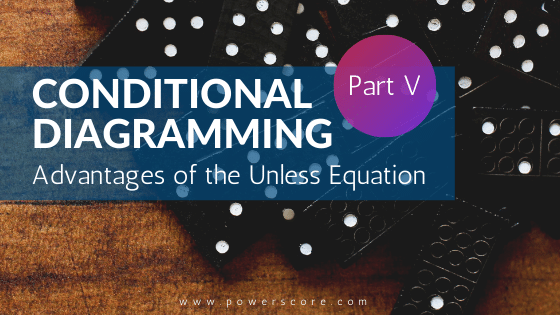Students often ask if there is an easier way to handle conditional statements containing necessary condition indicators such as “unless,” “except,” “until,” and “without.”
The Unless EquationTM
This is relatively simple, but it does involve a two-step process:
- Whatever term is modified by “unless” becomes the necessary condition.
- The remaining term is negated and becomes the sufficient condition.
For example, consider the following:
Unless you try, you won’t succeed.
Since “unless” modifies “you try,” “trying” becomes the necessary condition. The remainder, “you won’t succeed,” is negated by dropping the “not” and becomes “you will succeed.” Thus, the sufficient condition is “succeed,” and the diagram is as follows:
Succeed –> Try
Some students are understandably frustrated by this two-step process and try to simplify it. For instance, many turn “unless” into “if not.” Thus, they immediately “translate” the above-mentioned example into the following statement:
If you don’t try, you won’t succeed.
Because this statement follows a simple “if … then” construction, it is easy to diagram:
Try –> Succeed
The resulting diagram is obviously correct, as it is the contrapositive of the statement we produced using the Unless Equation. While it seems like this approach would save a step, it really doesn’t: since positive terms are generally simpler to use, you will probably resort to using the contrapositive of your own diagram. This, of course, would add a step. What’s worse, you’ve just put yourself at a higher risk of making a mistake. Here’s why:
Multiple Necessary Conditions
Let’s say you have multiple necessary conditions. Consider the following:
Unless you try and trust yourself, you won’t succeed.
Clearly, there are now two necessary conditions for success: “trying” and “trusting yourself.” If you merely substituted “if not” for “unless,” you would have the following translation:
If you don’t try and trust yourself, you won’t succeed.
This statement is inherently misleading, because “trying” and “trusting yourself” are both necessary conditions for success. Consequently, not trying or not trusting yourself would be sufficient to preempt success. The correct translation, in other words, should have been this:
If you don’t try or trust yourself, you won’t succeed.
By using the Unless Equation, you avoid the risk of such misinterpretation. All you need to do is remember that “unless” modifies the necessary condition(s) as they are—no need to convert “and” into “or,” or vice versa. The remainder is negated to become sufficient. Thus, our diagram would look as follows:
Try
Succeed –> +
Trust
Using the Contrapositive
Should you decide to use the contrapositive, you need to keep in mind that “and” becomes “or” and vice versa. This is something you can easily miss if you skip a step by turning “unless” into “if not”: essentially, you’re trying to go straight into the contrapositive, which is risky in the context of more complex conditional statements.
Ideally, as with all of our techniques, there will come a time when you don’t have to think about them. You’ll just apply them intuitively, just like you don’t consciously think about grammar every time you speak or write. Until then, be mindful of “shortcuts”: they can at times help, but more often than not they can take you down the wrong path.


Leave a Reply